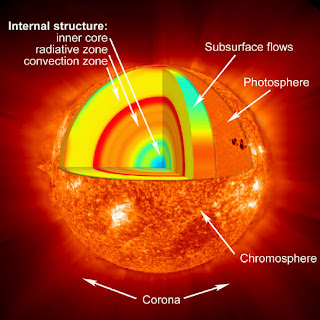Introduction
The nearest star to earth is more than just a bright light in the sky. It is what makes life on our planet possible. Billions of years in the future, it will also end life on the earth. The sun is a yellow main sequence star, made up of helium and hydrogen. The huge amounts of heat and light energy that it gives of are the result of nuclear fusion in its core, where hydrogen is changed in to helium.
Space Visits
No human being will ever walk on the surface of the sun. Apart from the fact that it is a ball of burning gas without a solid surface, the tremendous heat and its volatile nature make it impossible for manned spacecraft to approach too closely. However, In 1990 a solar probe called "ULYSSES" was launched to look at the poles of the sun. From earth, we can only see the area around the sun's equator.
Some More.....
1) At any time there are over one lakh short lived spicules in the chromosphere. These straight jets of gas last up to ten minutes before appearing to melt into the corona.
2) The energy from the core passes through the radiative zone, which is about 380,000 Km thick.
3) The core is a massive nuclear reactor, where hydrogen is fused to create helium.
4) Solar flares are huge explosions taking place in chromosphere each one is million million times more powerful that the first nuclear bomb.
5) Solar prominences are jets of flaming hydrogen that are held in the corona in by the magnetic field of the sun. They spot from the sun at enormous speeds and can reach 5 lakhs Km in height. Some form an arch and are called looped prominences
6) The convective zone consist of circling currents, taking heat out towards the photosphere. It is about 140,000 Km thick.
7) The outer atmosphere of the sun is called the corona. It is a halo of hot gas with a temperature of 1,000,000 degree celsius.
8) Rising 1,000 Km above the photosphere is the chromosphere, a reddish layer of hydrogen with a temperature that varies from 4,000-8,000 degree celsius.
9) The white hot photosphere is made up of hydrogen at a temperature of 5,500 degree celsius.
10) Darker areas are called sunspots. These areas of cooler gas happen when the suns magnetic field blocks flow of heat from the core. Sunspot activity peaks every 11.5 years. Key dates are 1990, 2001, 2012.
The Solar Winds
Charged particles are constantly being given off by the Sun. They are solar winds and are strongest when sun spot activity is at its height. When the solar wind reaches the earth's magnetic field, the charged particle interact with gases in the earth's atmosphere 10 Km above the surface the interaction causes the particle to emit light which is seen from the earth as a white or multi colored lights show, most visible within the polar circles. In the northern hemisphere this is known as "aurora borealis". the southern hemisphere sees the "aurora australis".
Facts And Figures
Diameter: 1,400,000 Km
Age: 4.6 billion years
Distance From Earth: 149.6 million Km
Surface Temperature: 5,500 degree celsius
Core Temperature: 15,000,000 degree celsius
Mass: 332,946 X Earth
Luminosity: 390 billion billion megawatts
Future Life: 5 billion years






0 comments:
Speak up your mind
Tell us what you're thinking... !